The place to sometimes find out the easy way what others found out the hard way...
Holiday Decorations
Raising a litter, really!!??
Squirrels and a Wheaten
Wheaten Herding Ducks?
Wheaten Sheepdog?
Porcupine Encounter!
Travelling with a Wheaten
Paw Protection
Pet Night Lights
Camera Batteries
Holiday Decorations Are Not For Eating
December 2008 - From Suann deCourcey, our 2008 Health/Education executive.
... FYI, information regarding toxic holiday decorations and potential remedy if some of these items have been mistakenly eaten. Although I have never used these remedies it may come in handy at some time. However, my best advise would be to get to the emergency vet clinic ASAP.
Cotton Ball Remedy
What do you do if your puppy (or mischievous older dog) gets into your holiday decorations and east some of the glass ornaments? This is potentially lethal mishap can darken even the brightest holiday season.
BEFORE the holiday go to a pharmacy and buy a box of cotton balls. Be sure that you get the COTTON balls.not the cosmetic puffs that are made from man-made fibers. Also, buy a quart of half-and half coffee cream and put it in the freezer. Should your dog eat glass ornaments:
Defrost the half-and-half and pour some in a bowl. Dip cotton balls into the cream and feed them to your dog. Dogs less than 10 lbs. should eat 2 balls which you have first torn into smaller pieces. Dogs 10- 50 lbs. should eat 3-5 balls and larger dogs should eat 5-7. You may feed larger dogs an entire cotton ball at once. Dogs seem to really like these strange treats and eat them readily. As the cotton works its way through the digestive tract it will find all the glass pieces and wrap itself around them. Even the teeniest shards of glass will be caught and wrapped in the cotton fibers and the cotton will protect the intestines from damage by the glass. Your dog's stools will be really weird for a few days and you will have to be careful to check for fresh blood or tarry appearance to the stool. If either of the latter symptoms appear, you should rush your dog to the vet for a checkup but, in most cases, the dogs will be just fine.
Hydrogen Peroxide Remedy
Use one teaspoon of hydrogen peroxide for each ten pounds of body weight can quickly induce vomiting. If you're fresh out of hydrogen peroxide, try a combination of one tablespoon of dry mustard and one cup of cold water. But, vomiting should never be induced when trying to purge caustic substances such as drain cleaner and petroleum-based products that can burn twice---once when they do go down and again if they are vomited. Also, if your dog is having trouble breathing, having seizures, has a slow heart rate, is unconscious, or has a bloated stomach, never induce vomiting.
Toxic Holiday Stuff From the National Animal Poison Control Center (NAPCC)
PLANTS
Mistletoe- Very toxic, all parts, especially the berries.
Holly- Moderate to very toxic, especially the berries and leaves.
Poinsettia- Leaves and stems low in toxicity.
Christmas Greens such as Balsam, Juniper, Cedar, Pine, & Fir- All parts of these plants have a low level of toxicity.
Holiday Decorations
Bubbling Lights- Moderate to lethal toxicity, depending on the amount of fluid (methylene chloride) inhaled or ingested.
Fireplace Colors (fire salts)- Moderate to lethal toxicity. Symptoms are gastrointestinal irritation with vomiting and a variety of other manifestations, including convulsions.
Angel Hair (spun glass)- Low toxicity; can cause irritation of the eyes, skin, and gastrointestinal tract.
Christmas Tree Preservative Solution- Low toxicity, depending upon formulation and quantity ingested.
Snow Sprays & Snow Flock- Low toxicity, dry particles are inert; however, toxicity from inhalation can occur if sprayed directly in mouth.
Styrofoam- Low toxicity; can cause choking from mechanical obstruction.
Christmas Tree Ornaments- Non-toxic, but mechanical irritation or obstruction of the gastrointestinal tract can occur if ingested.
Icicles (tinsel)- Non-toxic, however intestinal obstruction and choking are potential problems.
Snow Scenes- Toxicity may come from organisms possibly in the water, most notably Salmonella.
* Read label warnings on all decorations and take the necessary precautions to protect your pet. *
Gifts & Miscellaneous Items
Button Battery (disk battery)- Caustic, potentially high toxicity depending upon the position of the battery in gastrointestinal tract.
Aftershave Lotion, Colognes, Perfumes, Alcoholic Beverages- Ethanol in various concentrations is moderately toxic depending upon the amount ingested. The high concentrations of essential oils in true perfumes are especially toxic.
Plastic Model Cement- Moderate toxicity.
Epoxy Adhesive- Uncured hardener: moderate to high toxicity. Uncured resin: low toxicity, primarily irritation and sensitization.
Adhesives, Super Glue- Low toxicity, most difficulty occurs when eyelids become bonded together.
Artists Supplies: Crayons, Felt Tip Markers, Pencils, Water-based paints- Low toxicity; however, may cause more than a mild mucous membrane and gastrointestinal irritation.
Petroleum-based Paints- Low toxicity; primary concern is possibility of aspiration.
Toys- Avoid toys with parts small enough to be pulled off and swallowed and toys painted with toxic materials, etc. Use same precautions as with children.
From the National Animal Poison Control Center (NAPCC), a non-profit, cost-recovery program at the College of Veterinary Medicine, University of Illinois in Urbana, IL.
If you suspect your pet has been poisoned, you should call your veterinarian or you can call the NAPCC. This is not a free call. Telephone numbers for the NAPCC are: 1-800-548-2423 ($30 per case, credit card only; free follow-up calls until problem is resolved.) 1-900-680-0000 ($20 for 5 min., $2.95 per min. thereafter.)
|
Raising Puppies or We're Going to Do What!






Sometimes life gives you great opportunities, here's Gail, Ray and Travis' adventure.
"In the spring of 2007 the Provincial Veterinarian shut down a puppy mill in the Morden area and all the animals were taken to a Vet in Steinbach for treatment and evaluation. While in custody the Wheatens, 2females and 1 male were kept together in one pen/run. Shadow, one of the females, came into season and was bred by the male Wheatens while in custody. The puppies were born in custody. When the puppies were about 2 weeks old the Provincial Vet gave the order to place the animals with various organizations for adoption. Shadow and her 8 puppies ended up at D'Arcy's Ark. D'Arcy staff weren't sure that these were Wheaten puppies and called me. Ray and I went down and check the dogs and confirmed that yes, they had 3 Wheatens - 2 females and 1 male. We also confirmed that these were Wheaten puppies. I put together a package of information on Wheatens for D'Arcy and for them to provide to their prospective owners. At this point I thought my contact with the Wheatens was over.
About a week later, I received another call from D'Arcy. Another female with puppies, a Beagle with Puggles (Beagle/Pug cross), was in foster care. The foster Mother had gotten a job and needed to bring the Beagle and pups back to the shelter. Would I be able to foster the Wheaten mom and pups until they were ready for adoption? I took the weekend to think that over, and after talking it over with Ray we decided to foster. Travis was all for it as soon as he heard about it!"
|





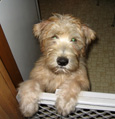
"On the Monday, I picked up the Mom, named her Shadow because she followed me every where, and brought everyone home. It was a "community project", as I chose to keep the litter in my kitchen. The Salisbury House where our coffee group meets, the neighbours, our friends and family all saved newspapers for me. I was obsessed with keeping the kitchen and puppy area clean and odour free - I succeeded! I also had another breeder inspect the pups to ensure that my evaluation of them being Wheatens was accurate After the pups had their first shots, I arranged for various visitors to come, and have contact with the pups. After school, my house was a buzz with children - no more than three at a time - to play with the puppies. I also had seniors and various others come in. Two of D'Arcy Ark vets, 1 from Birchwood and 1 from Centennial, told me that these were some of the most well socialized and sound puppies they had ever seen.
The puppies did not go to open adoption at D'Arcy's, they were placed into hand-picked homes by Darcy. Laurie G called me the day I was taking the puppies in, and encouraged me to keep one since I had decided not to keep Shadow. I ended up keeping the only male, Magnum and the smallest female, Muggins. The original three adult Wheatens were also placed in good homes by Darcy.
I can only claim some sort of "temporary insanity" for taking two puppies. They are certainly a handful but I get an enormous amount of pleasure from them. Some of the puppies and their owners are now members of WOTR.
I found it very interesting in that out of a litter of 8 puppies, 2 were reds and had Irish coats, while the remaining 6 had typical wheaten colouring and North American coats.
My fostering of the litter had nothing to do with rescuing. My only contribution as Rescue Co-ordinator was identifying the adults and litter and providing some information. The fostering part was my soft personal side."
|
A Wheaten and a Squirrel
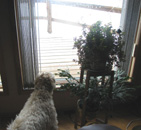
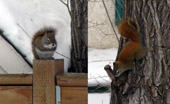
From Phil G:
"Pretty much every day we have built-in entertainment from our family room. You see, a red squirrel (sometimes 2) has taken up residence in our back neighbour's shed. It comes out most days and poses on a fence post as if to say: "Dog, I know you're in there..." Our Wheaten Toby reacts as expected; when he sees some movement at the back fence or in the many tall trees, he goes to the middle window, his body goes rigid, his tail quivers and if that darned squirrel should happen to run along the top of the fence, well all hell breaks loose. He skitter/slides/barks accross the hardwood floor into the kitchen, slipping/sliding/barking down the hall to the back door where he begins to yelp/bark/growl incessantly. The only relief if for one of us to let him out. His nose pushes against the storm door an he is gone, barking and running full tilt along the fence. Of course the squirrel has heard both the barking and the stealthy door opening sound and has already taken refuge in higher branches, occasionally scolding Toby. To ensure the squirrel stays in the area I often leave a trail of peanuts and black oil seeds on the fence top... This squirrel fun continues
 at our cottage as well with the added bonus of a several chipmunks. Lots of laughs and good exercise for Toby.
at our cottage as well with the added bonus of a several chipmunks. Lots of laughs and good exercise for Toby.
The other part to this fun is how your pet dog shapes your language.
In our home the words "squirrel", "cat" or even the letters "SQ" cannot be used as they are immediate signals to the dog - full alert - outside for the chase! The restricted use of "cat" is a bit strange as our cat is 13 yrs old while the dog is not yet 6! Somehow Toby does not associate the word "cat" with Mokie. They are fast friends and play quite often. Dogs, you gotta love them.
A Wheaten and Ducks
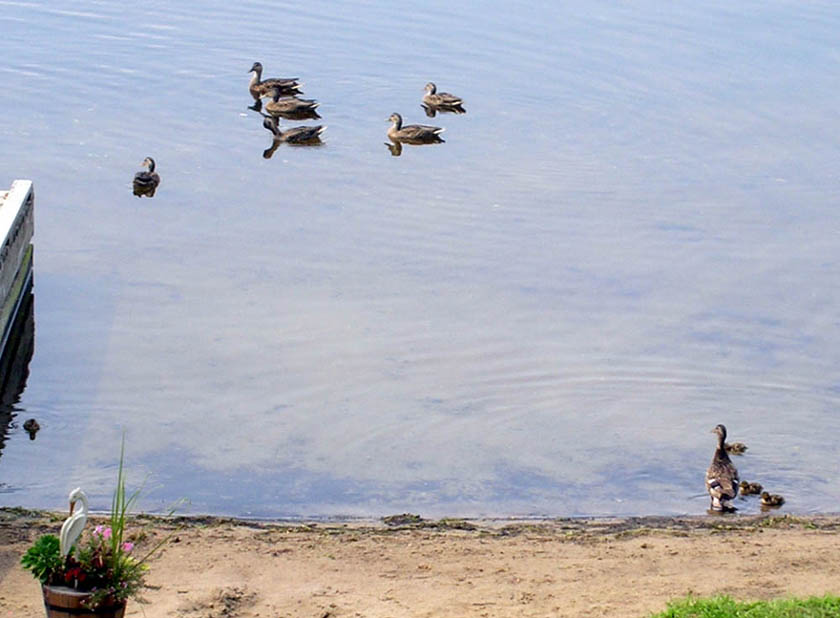
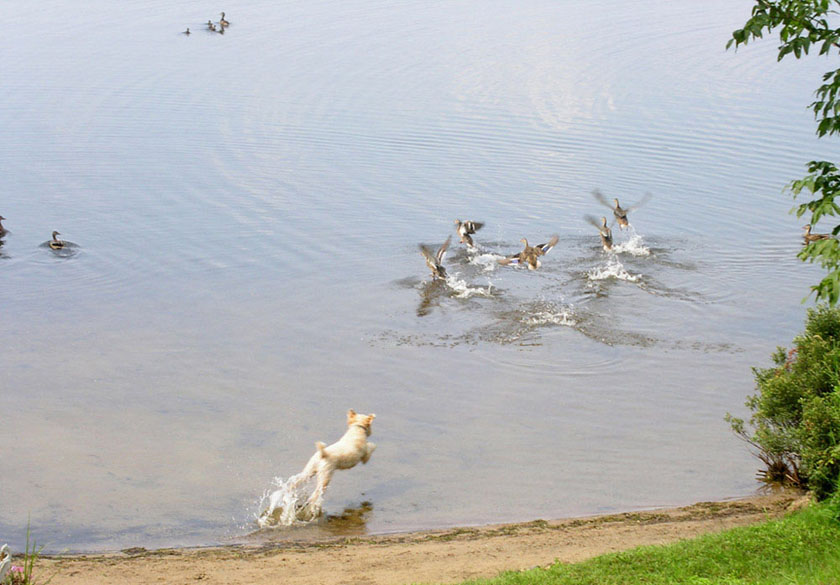

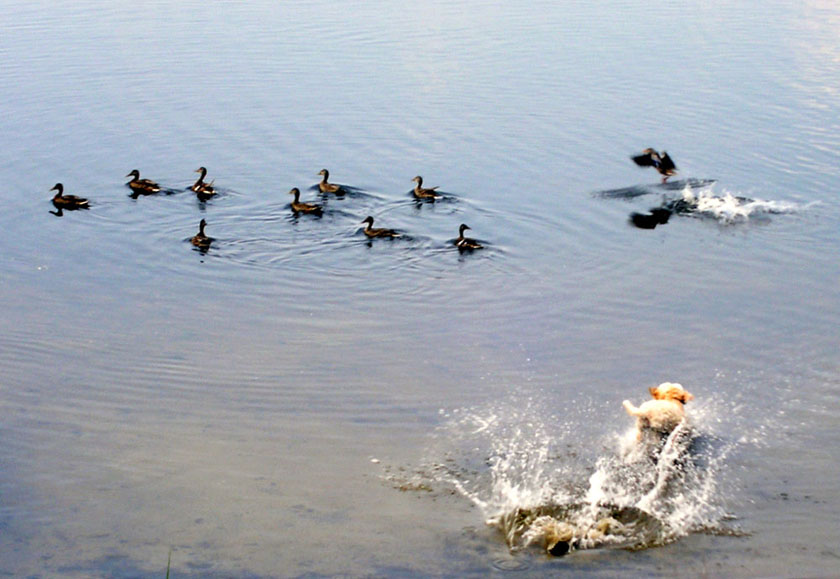
From Phil G:
"A picture on 'Simply Snaps' shows that both Bogey and Toby like to herd ducks. In early August this year
Toby provided us with many minutes of entertainment herding a flock of ducks. I don't think he would harm the ducks as he doesn't bark, he simply charges at them. He can get within a couple of feet of several of them and then when he turns to go back to shore, they get much closer to him. I wonder what he would do if he actually caught one!"
Starting and Success - Wheaten Sheepdogs, No Kidding!
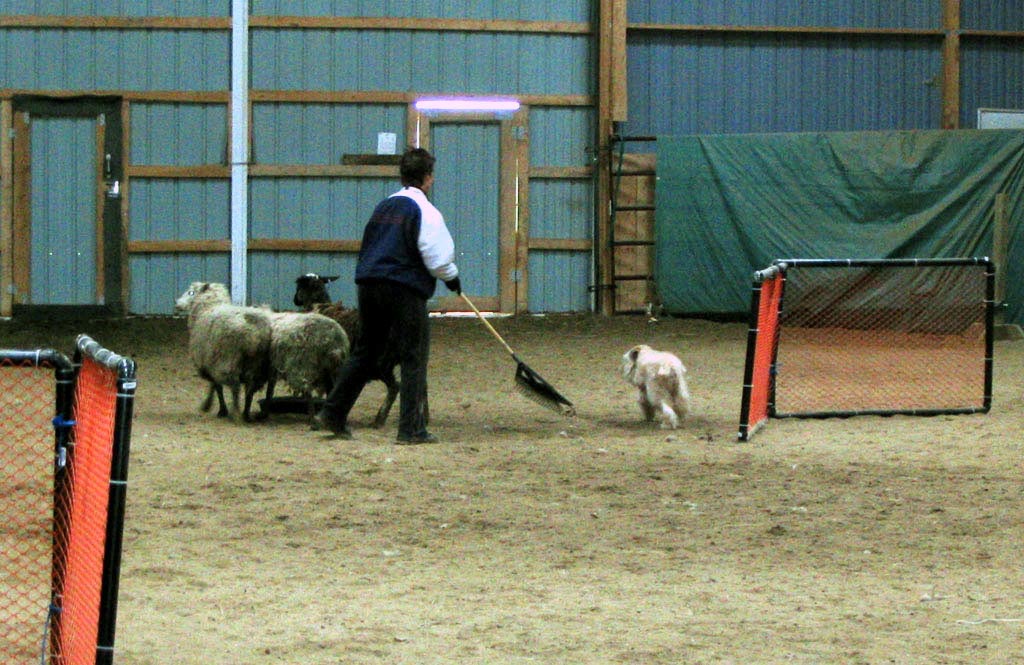
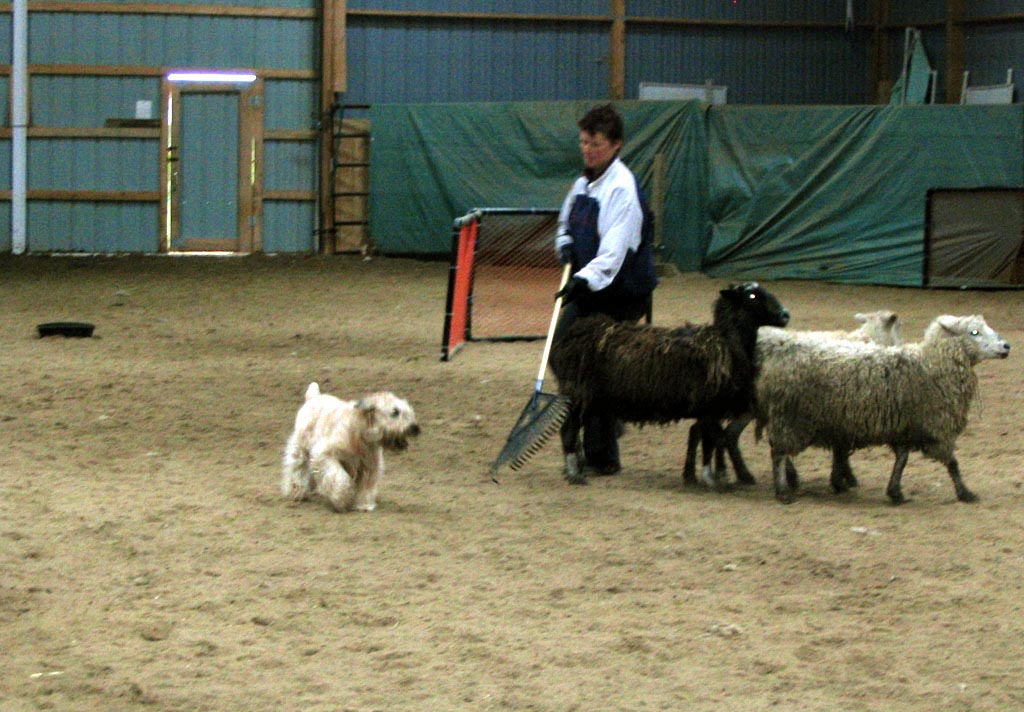
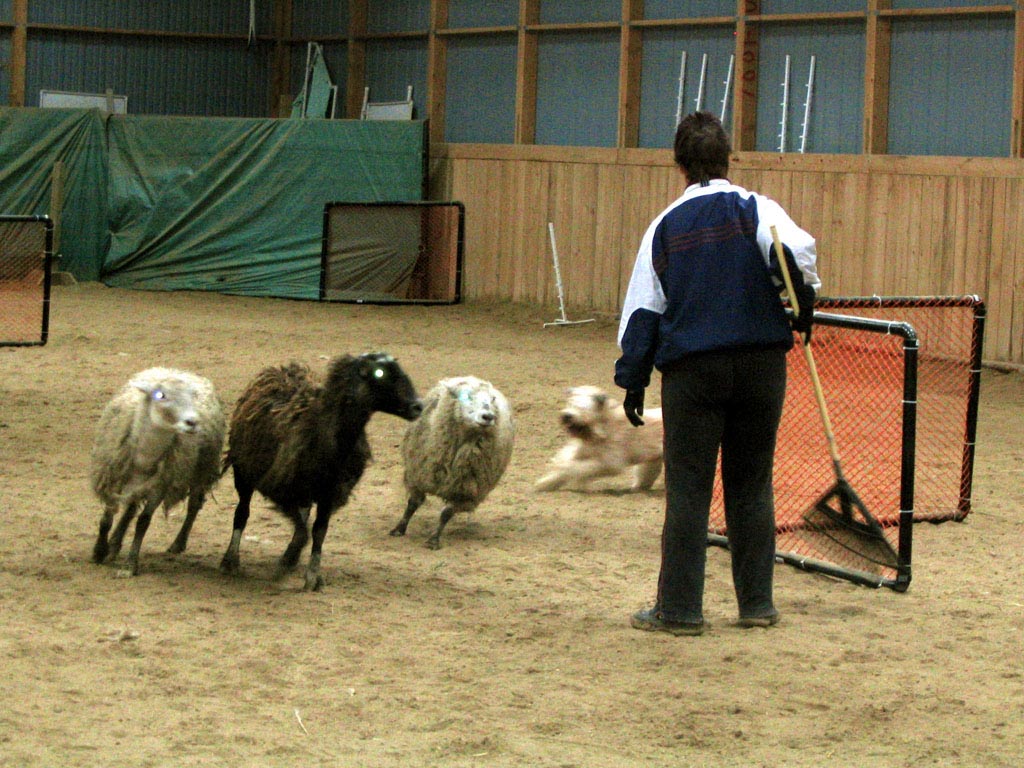

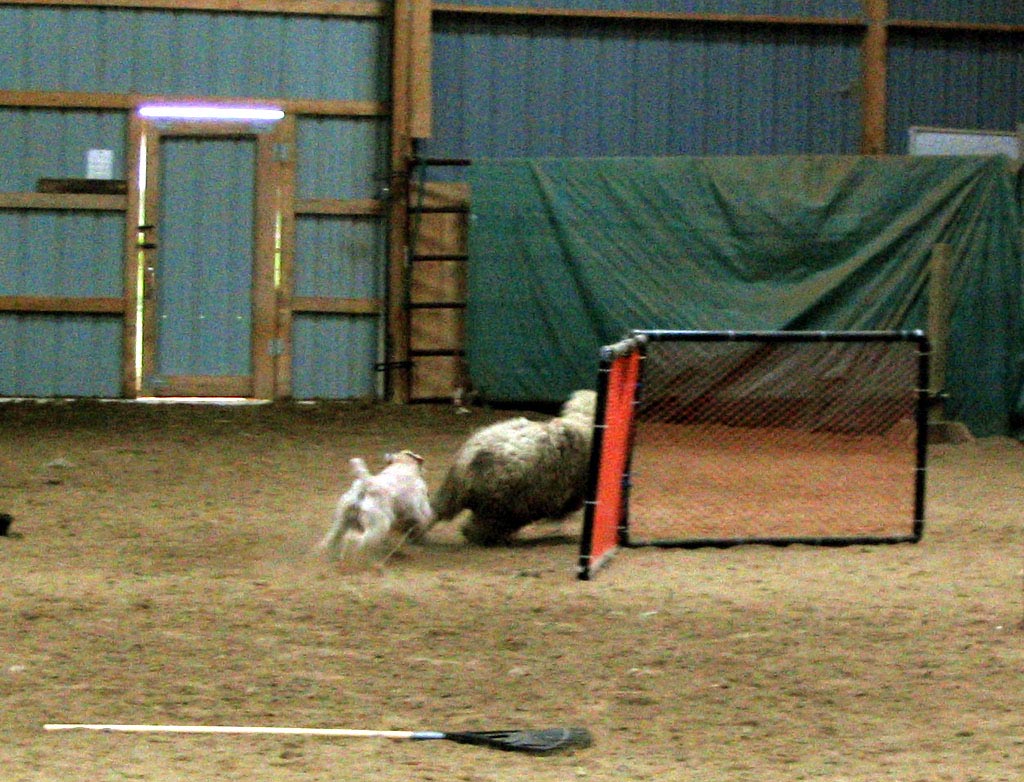
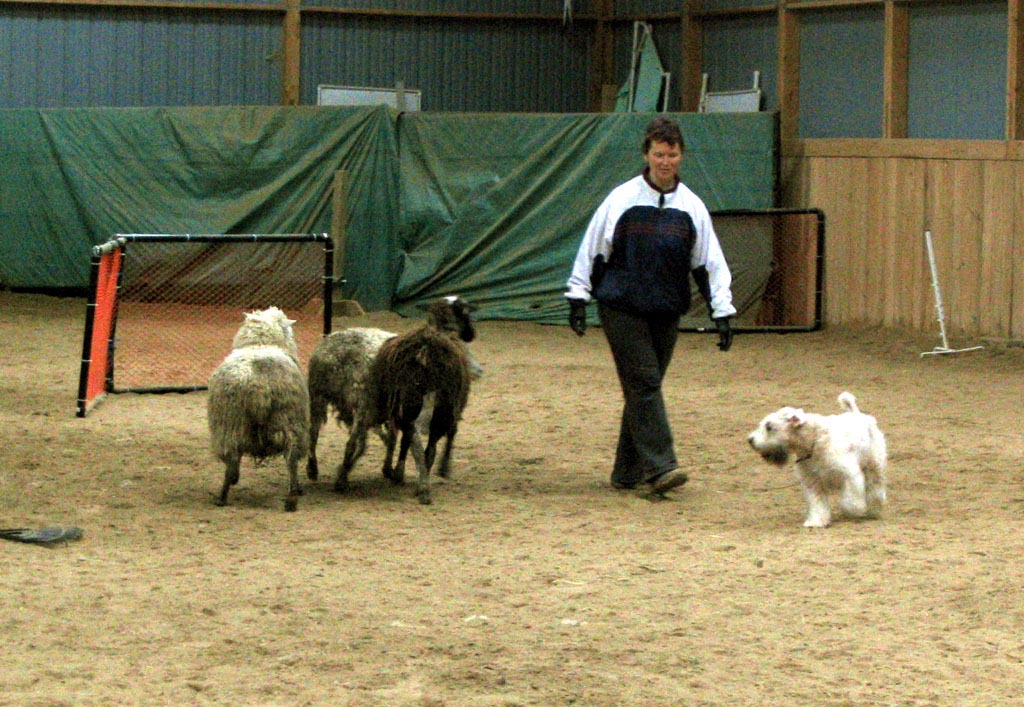
From Eileen O: "Today was our 2nd attempt at sheep herding - they move pretty fast! The lady doing the handling
gets the dogs used to sheep etc. and than we get to go in the ring. Hah!! I am watching those sheep and wondering
if I want to.
|
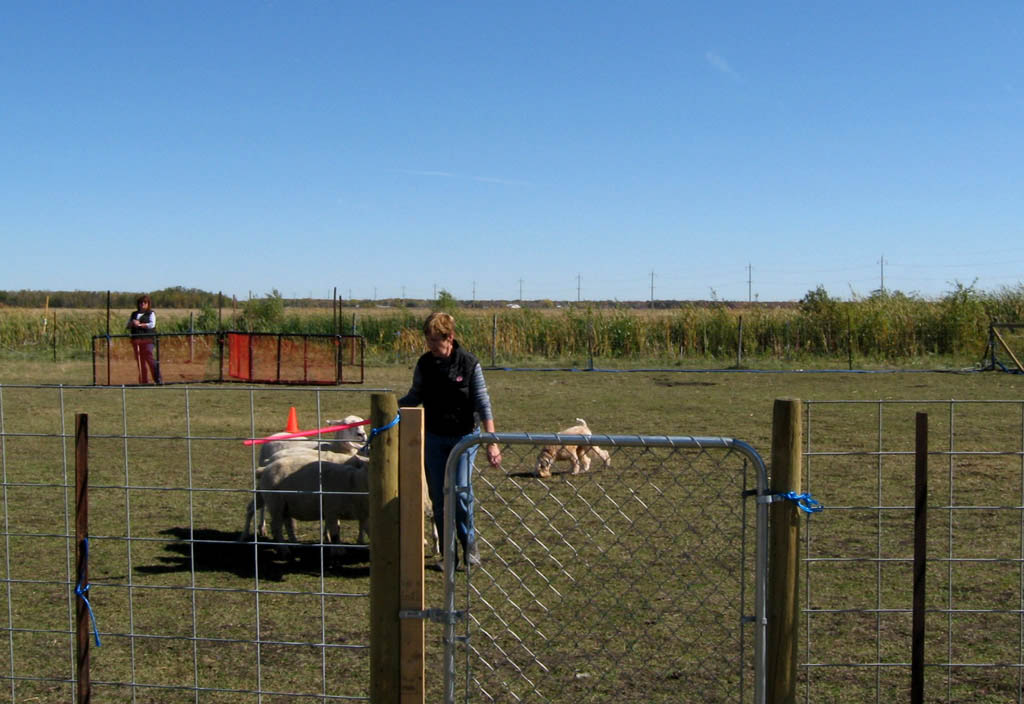

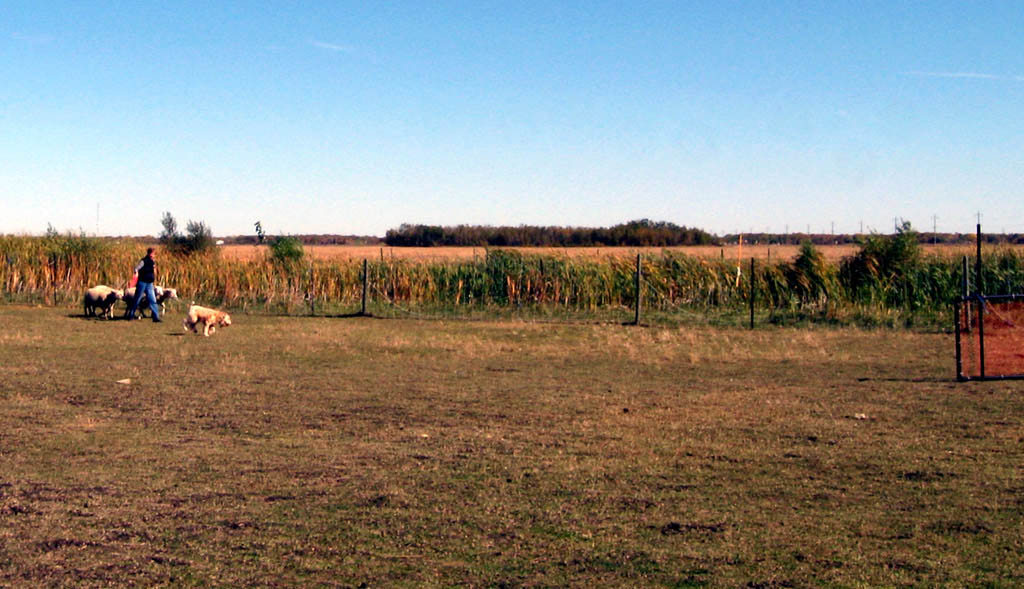

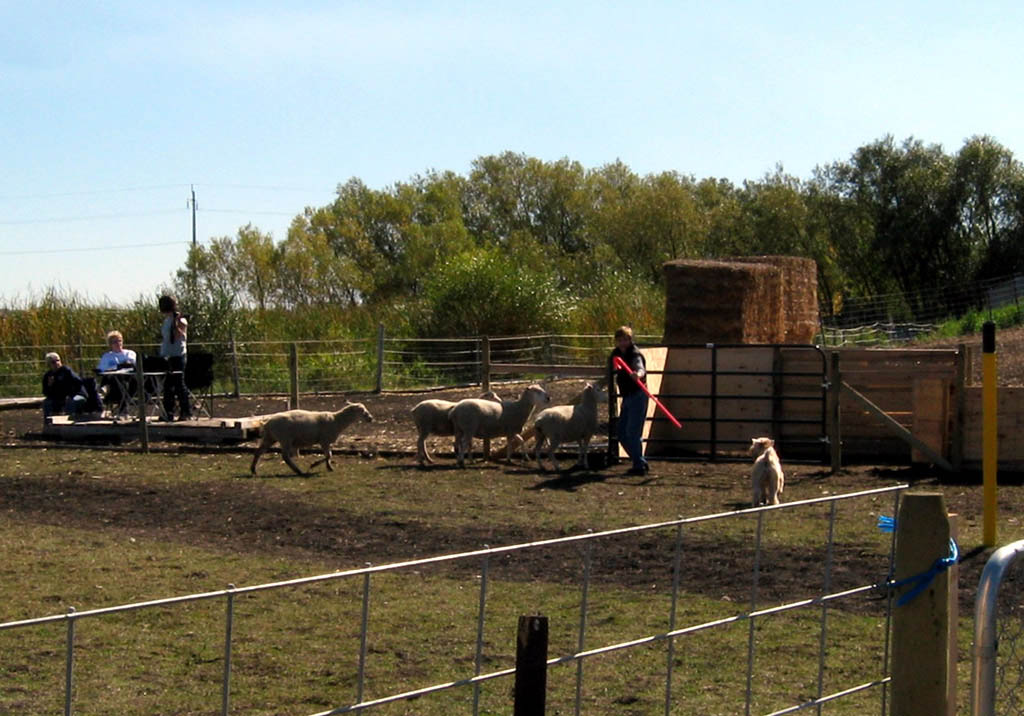

"I am thrilled with the herding event over the 2 days. First time I was alone in the pen with dog and sheep and did the course. Object is to pass 2 trials under different judges and you attain the CKC herding tested title (HT)
Saturday Neelu qualified in the morning and was superb in the afternoon to attain the title.
Signe was really good on Saturday and in the afternoon said she wasn't about to chase any sheep. Sunday morning she went out and did a really fine job so she attained her title. The judges were most impressed with the wheatens and encouraged me to trust my dogs more and learn my part. I think I will continue over the winter."
|
Some Critters Are To Be Avoided!
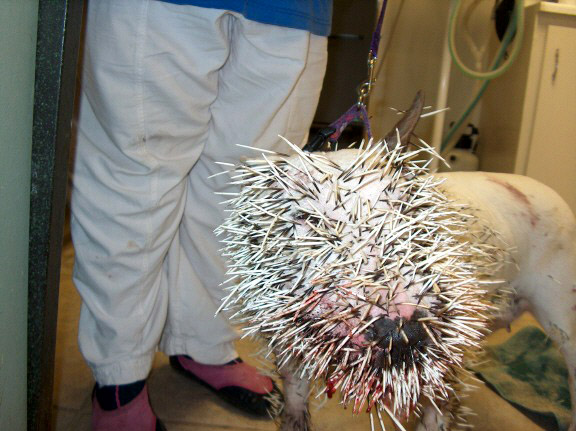
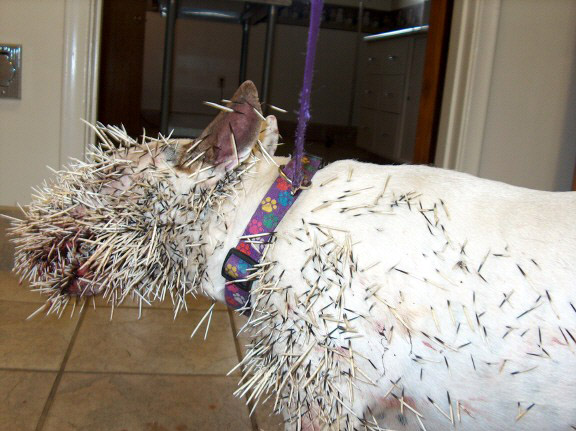
A Bull Terrier decided he would battle a Porcupine in back of his house in Southern California. But being both brave and stupid, he ultimately learned the hard way that you can't always win, no matter how tough you are.
A vet sedated the dog and then removed a total of 1,347 quills. The dog survived and hopefully learned a valuable lesson - but then it is a terrier...
Travelling (by car) with your Wheaten
Eileen O travels to and participates in many dog shows and I asked her to share her experiences and tips with us.
So, in no particular order, here are some of her observations/tips:
- We now tend to stay at the higher end motels. We tell the motel we have our crates and of
course you have to walk in with your dogs after and pretend they are perfect. One thing, we do not allow barking.
- When you drive up check if there is an area to walk dogs preferably grass.
- Are there side entrances so you don't have to walk thru the main lobby.
- Complimentary breakfast is a bonus and worth the extra price; a fridge and microwave is a bonus
- Check the room for size expecially if traveling with a few dogs (need room for crates).

- Size/weight may not matter if you promote non shedding Wheatens.
- Try for a main floor near exit.
- Don't use the hotel towels on your dog.
- If there is a fee for the dog than ask if they will do better on the room rate. Keep in mind if the fee
for the dog is high than try another location because they really don't want your business.
- If the weather is inclement, make sure to have something to wipe the dog's feet off.
- Motel location guide books are very useful for identifying if dogs permitted.
- Always ask for the best rate; CAA, senior, rack rate etc. especially if the motel isn't full.
- Be as quiet as possible when taking the dog in and out during all hours.
-
Most important pick up after your dog
Protecting your Wheaten's sore paw
This is the second year in a row that Toby has suffered a tear in a paw. He seems to
do this just before we leave for a winter vacation. Maybe he's jealous but we do hire a dog/cat/house sitter
whom he loves. Anyway, Toby continued to lick his paw, the wound wouldn't heal and the tear extended.
As a precaution our pet's guardian took him to the vet.
Now we all know how dogs hate to have something on their feet or something that inferferes with their natural
instinct to lick their wounds - who has not seen a dog with a lampshade on its neck like a sideways funnel!
Our vet however had a good idea.
Over the taped foot we place a City of Winnipeg poop bag as it is a good size, and over that we place a 1
litre iv (intravenous) bag and tie it around the leg with folded gauze. It is very effective at keeping the
foot dry and not wearing out the tape bandage. This is week 3 and at least another week to go. Paw pad
injuries take a long time to heal and of course the wettest time of the year is approaching.
 Here is Toby going for the sympathy vote with his injured foot. This was day 4, now he simply walks
everywhere on all fours. Don't worry, he chases our cat with the same gusto and abandon with or
without the bandage. It's a real problem trying to keep it dry as it only changed every Monday
morning.
Here is Toby going for the sympathy vote with his injured foot. This was day 4, now he simply walks
everywhere on all fours. Don't worry, he chases our cat with the same gusto and abandon with or
without the bandage. It's a real problem trying to keep it dry as it only changed every Monday
morning.
|
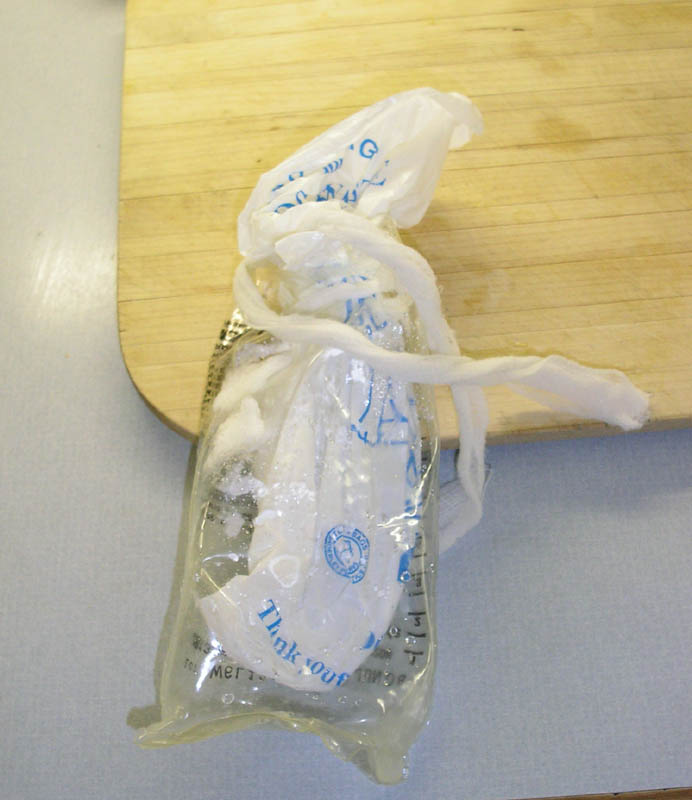 The rather ingenious bandage protection unit; poop bag then iv bag from the vet's - smart!
The rather ingenious bandage protection unit; poop bag then iv bag from the vet's - smart!
|
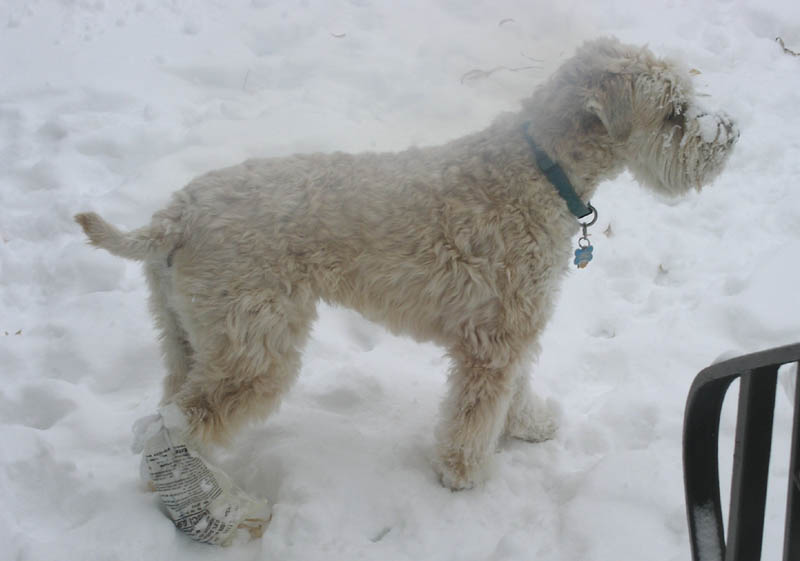 Getting used to having this "thing" on his foot. Toby normally walks on three feet but if sees a
squirrel or rabbit it's all fours!
Getting used to having this "thing" on his foot. Toby normally walks on three feet but if sees a
squirrel or rabbit it's all fours!
|
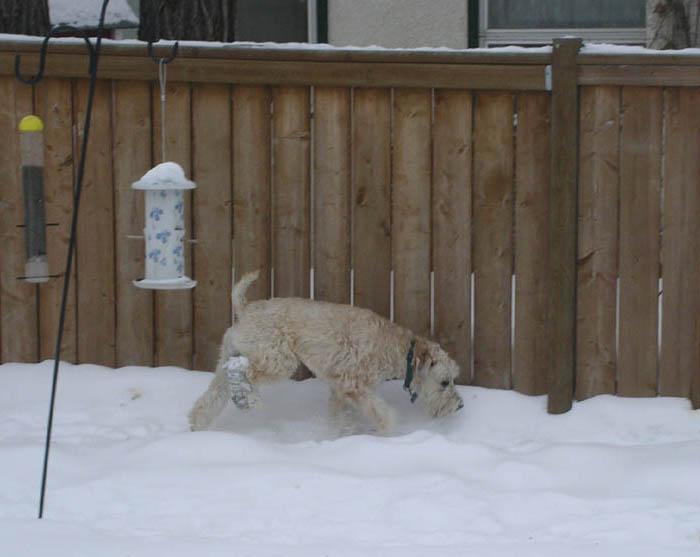 It works! Toby and I have reduced his daily walks to a mile or less per day but still on the Trans
Canada Trail.
It works! Toby and I have reduced his daily walks to a mile or less per day but still on the Trans
Canada Trail.
|
Night lights - making sure your Wheaten can be seen
I like to walk at night, especially in the winter, and I like to see where my Wheaten is! Over the last 5 1/2 years I have experimented with many collar light arrangements. I am now satisfied that I have found an effective (and not expensive) solution.
» 1st, find an older or worn out collar. I make it very loose so it slips over the head easily. In fact our Wheaten could pull it off if he wished.
» 2nd, purchase a light, and if your dog walks in open fields especially in the winter, purchase 2 lights. Colour should be white, or (not as effective), red. A bright white LED light is best and I recommend a steady/flashing light.

Mountain Equipment Co-op sells very effective and inexpensive units. A steady/flashing red light is much easier to find, try MEC again or Canadian Tire. This unit should be attached to the bottom clasp or bottom rung of the collar and should be powered by 2 AA cells which gives the unit enough weight to center the collar.
» 3rd, a few strong elastic bands (the ones holding bunches of asparagus work well!).
The elastic bands are used to attach both lights. It is a little more problematic to rig the top light so it more or less stands up. The effort is well worth it as the straighter the light stands, the more effective it is!



Many winter nights Toby and I walk south on Municipal road, near the railway and many times we cross or walk on popular snowmobile trails. We are always cautious and I keep a sharp look out. When we spot them coming a fair distance away, we get off the track and face them and I hold Toby by the collar. They can see Toby's lights and just in case, many times I turn on my LED headlight!
Touch wood, the snowmobiles always slow down and either get off their own path or pass very slowly. We generally wave at each other to show we are both enjoying our hobby.
Toby also wears his light collar when we are at the lake in the summer as he tends to go a long way away at night and I sort of like to know where he goes - plus the deer can see him easier.
Click here to see a little video of Toby's night lights in action.
Batteries For A Digital World
Many of the devices in our modern world use AA or AAA batteries; the ubiquitous TV remote, digital cameras, mp3 players, hand-held GPS units, the list goes on. These devices are all good but battery consumption is out of sight! I have had a GPS unit for 4 years and these devices go through alkaline batteries like sh** through a goose. My solution was to purchase 4 Nickel Metal Hydride (NiMH) rechargeable batteries and a suitable charger. This was and is a very good solution as these batteries can handle about 1000 charges with minimum effort on my part. However, over time, the performance of NiMH batteries can deteriorate and you feel compelled to buy new ones.
Hold on, the problem may not be the batteries but rather the crude charging unit.
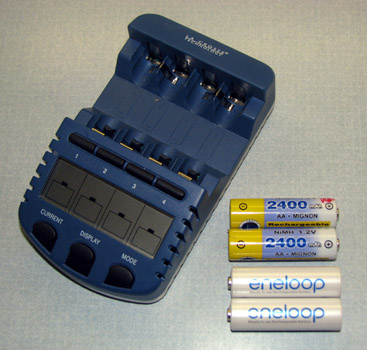
I learned about batteries and chargers from the excellent camera website
Steve"s Digicams. In a nutshell, department store chargers stop charging either at a threshold temperature or a voltage. So if you're charging more than one battery at a time, charging will cease when the first battery reaches "charge" however, the remaining batteries may not have yet reached full charge. This charging cycle continues and obviously, over time, this leads to degraded performance.
After considerable internet research I purchased a processor controlled NiMh charger made by LaCrosse; less than $50us and included 4AA and 4AAA NiMH batteries. I also purchased additional eneloop batteries). This unit charges each battery independently of the others and performs discharge/charge cycles to determine optimum charge levels. The results are quite impressive and my old NiMH batteries perform like new. Another improvement is to use newer technology NiMH batteries (e.g. Sanyo eneloop) that hold a 85% or better charge for at least six months. Ordinary NiMH batteries will discharge over a couple of months even if they are not used. Now, in my Canon digital camera, I use 4 2400mAh NiMH batteries and keep 4 eneloop batteries as backup. When the 2400s are discharged I swap in the eneloops and charge the others and then switch again. I have converted all my AA AAA batteries to NiMH and I will not need to purchase any other cells for 4-6 YEARS!
Latest update is December 12, 2008




 at our cottage as well with the added bonus of a several chipmunks. Lots of laughs and good exercise for Toby.
at our cottage as well with the added bonus of a several chipmunks. Lots of laughs and good exercise for Toby.





 - Size/weight may not matter if you promote non shedding Wheatens.
- Size/weight may not matter if you promote non shedding Wheatens. Mountain Equipment Co-op sells very effective and inexpensive units. A steady/flashing red light is much easier to find, try MEC again or Canadian Tire. This unit should be attached to the bottom clasp or bottom rung of the collar and should be powered by 2 AA cells which gives the unit enough weight to center the collar.
Mountain Equipment Co-op sells very effective and inexpensive units. A steady/flashing red light is much easier to find, try MEC again or Canadian Tire. This unit should be attached to the bottom clasp or bottom rung of the collar and should be powered by 2 AA cells which gives the unit enough weight to center the collar.

 Many winter nights Toby and I walk south on Municipal road, near the railway and many times we cross or walk on popular snowmobile trails. We are always cautious and I keep a sharp look out. When we spot them coming a fair distance away, we get off the track and face them and I hold Toby by the collar. They can see Toby's lights and just in case, many times I turn on my LED headlight!
Many winter nights Toby and I walk south on Municipal road, near the railway and many times we cross or walk on popular snowmobile trails. We are always cautious and I keep a sharp look out. When we spot them coming a fair distance away, we get off the track and face them and I hold Toby by the collar. They can see Toby's lights and just in case, many times I turn on my LED headlight! I learned about batteries and chargers from the excellent camera website
Steve"s Digicams. In a nutshell, department store chargers stop charging either at a threshold temperature or a voltage. So if you're charging more than one battery at a time, charging will cease when the first battery reaches "charge" however, the remaining batteries may not have yet reached full charge. This charging cycle continues and obviously, over time, this leads to degraded performance.
I learned about batteries and chargers from the excellent camera website
Steve"s Digicams. In a nutshell, department store chargers stop charging either at a threshold temperature or a voltage. So if you're charging more than one battery at a time, charging will cease when the first battery reaches "charge" however, the remaining batteries may not have yet reached full charge. This charging cycle continues and obviously, over time, this leads to degraded performance.



























